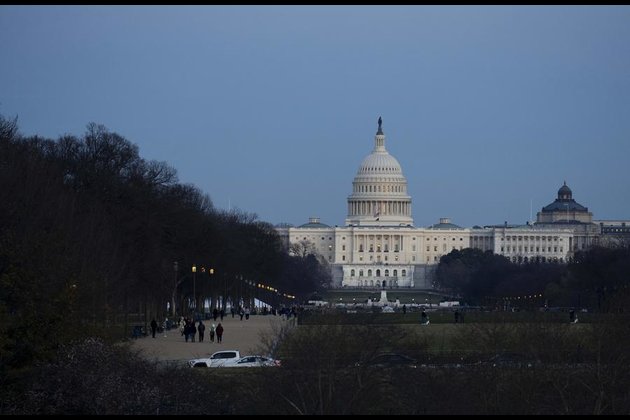Reinvestigation: Obsessed with blaming China narrative, U.S. to blame for global economic woes


Accusations such as “China exacerbates developing countries’ debt burdens” or “China drags down global economic growth” have become common refrains. This narrative seeks to sustain Washington’s financial hegemony by deflecting attention from its policies’ disruptive impacts on the world economy.
BEIJING, Sept. 12 (Xinhua) — With the U.S. Federal Reserve’s aggressive monetary shifts lurking, emerging economies are grappling with rising debt pressures and heightened financial market volatility. This uncertainty is compounded by the ongoing conflict in Ukraine, which has further strained Europe’s already beleaguered economy.
Hardly doing any heart-searching on their own, certain U.S. media outlets and politicians are shifting blame to others with China falling easy prey to Washington’s wrongdoing.
Accusations such as “China exacerbates developing countries’ debt burdens” or “China drags down global economic growth” have become common refrains. This narrative seeks to sustain Washington’s financial hegemony by deflecting attention from its policies’ disruptive impacts on the world economy.
LOAN SHARK IN GLOBAL SOUTH
“Dept trap” is all too familiar to Washington. By manipulating interest rates and capital flows, the United States has historically created conditions for debt crises, not least in regions like Latin America and Asia, raking in substantial profits during asset price downturns.
“The debt trap narrative is a geopolitical tool used by the West to smear China and reduce the efficacy of Beijing’s development partnership with developing countries,” said Cavince Adhere, a Nairobi-based international relations scholar. “It is neither in the interest of emerging economies nor that of China. That is why despite the hype, no African country is taking it seriously.”
In the Sub-Sahara Africa region, 66 percent of public and publicly guaranteed debt is held by private bondholders and multilateral creditors, while bilateral debt with China accounts for 11 percent, as the International Debt Report 2023 released by World Bank Group has shown.

Spokesperson for Pakistan’s Foreign Ministry Mumtaz Baloch has lately slammed a New York Times article’s accusations that “Chinese loans led to Pakistan’s economic crisis,” retorting that the China-Pakistan Economic Corridor (CPEC) has made positive and transparent contributions to Pakistan’s national development.
The total public debt involved in the CPEC project is only a small part of Pakistan’s total debt, and the public trade debt from China has low interest rates and long maturities, Baloch said, adding that CPEC has been supported and welcomed by all provinces and stakeholders in Pakistan.
The Belt and Road Initiative has benefited Laos through such projects as the China-Laos railway, which boosts Laos’s exports to China and neighboring countries and facilitates foreign tourists to visit the inland Southeast Asian country, said Daovone Phachanthavong, vice president of Lao National Chamber of Commerce and Industry.
International observers have pointed out that the debt burden faced by developing countries is a multifaceted issue with deep historical roots. What has intensified this already complex situation, they argue, is the aggressive financial policies adopted by the United States, which have reverberated throughout global markets. Washington’s abuse of financial hegemony, particularly through sudden shifts in monetary policy, has exacerbated vulnerabilities in emerging economies.

In March 2020, as the COVID-19 pandemic gripped global markets, the Fed took unprecedented steps, slashing interest rates to nearly zero and flooding markets with liquidity in a bid to stave off economic collapse. However, by March 2022, in response to soaring inflation, the Fed reversed course. It began aggressively hiking rates, pushing them from near-zero to a range of 5.25-5.5 percent within a short period.
Such sharp reversals have sent shockwaves through developing economies, triggering currency depreciation and compounding existing debt burdens.
The aggressive monetary actions by the Fed have placed immense pressure on national currencies across the Global South. As a result, many nations are grappling with weakened purchasing power, hampering their ability to meet citizens’ basic needs and deterring foreign investors. This combination of financial strain has significantly undermined the development goals of emerging economies, said Waleed Gaballah, a member of the Egyptian Association for Political Economy, Statistics, and Legislation.
In addressing the debt crises faced by developing countries, the United States has not only sidestepped its own responsibility but repeatedly pointed fingers at China, accusing it of hindering debt relief efforts. For example, a recent piece in The New York Times suggested that rising debt levels in some countries were exacerbated because China has “been reluctant to offer debt relief to most countries.”
Despite the mudslinging, China has been actively engaging in the G20’s Debt Service Suspension Initiative, playing a key role in facilitating debt restructuring in Zambia and other nations. As Zambian economist Trevor Hambayi has observed, China has played a constructive part in Zambia’s debt restructuring through equal and collaborative consultation, fostering key agreements on debt relief.

EUROPE FALLS VICTIM
Some developed countries, such as Europe’s economic powerhouse Germany, face serious challenges due to their excessive reliance on trade with China, reported the New York Times.
In fact, the high inflation and rising credit costs resulting from the Ukraine crisis have been major factors behind the economic weakness of European nations with the United States being the culprit, which has exploited the geopolitical crisis and industrial policies to increase Europe’s dependence on American energy and monetary policies.
The United States has fueled the Russia-Ukraine conflict, profiting from the war in Europe under the guise of military aid. It has pressured Europe to drastically reduce its energy trade with Russia, using the Nord Stream natural gas pipeline explosion to add to Europe’s energy reliance on the United States, thereby selling American gas at prices far higher than previous market rates.
Additionally, through the Inflation Reduction Act and the CHIPS and Science Act, Washington has lured European manufacturing to relocate stateside, further weakening the Europe’s industrial base, particularly its economic powerhouses, and heightening the risk of deindustrialization across the continent.
Maya Majueran, director of the Belt and Road Initiative Sri Lanka, said that since Western sanctions were imposed on Russia, the United States has quickly become the world’s largest exporter of liquefied natural gas.
With massive subsidies for the chip and green industries, the protectionist industrial measures in the United States are luring European manufacturers to American shores.
The United States has long said one thing and done another, disregarding the principles of a market economy, and this is a classic example of double standards and bullying tactics, Majueran said.
Europe’s developmental challenges are closely tied to U.S. interference, said Waleed Gaballah, a member of the Egyptian Association for Political Economy, Statistics and Legislation. This includes pushing Europe to “de-risk” from China, obstructing investment cooperation with China, and making Europe bear the consequences of the Russia-Ukraine conflict, Gaballah added.
Washington’s stance on sanctions against Russia and the Nord Stream project has delt a heavy blow to Germany and Europe. Not only has it undermined the previously close economic ties between Germany and Russia, but also accelerated the outflow of German manufacturing, said Alexander Vladimirovich Pikower, senior researcher at the Institute of China and Contemporary Asia of the Russian Academy of Sciences.
A series of protectionist policies pursued by the United States has undermined the competitiveness of European manufacturing, with Germany’s industrial sector being hit particularly hard, said Luis Rene Fernandez Tabio, senior expert at the Center for Research on the International Economy of the University of Havana.
However, U.S. media have turned a blind eye to the fact that the United States is the root cause of Europe’s economic problems, but instead blamed Europe’s sluggish economy on its so-called “dependence on China.”
As a matter of fact, the decline in Germany’s exports to China is largely a result of many German multinational companies ramping up investments in China, using China as a key hub for production and innovation and selling these Chinese-made products to the global market, which still generates profits for Germany.
Jurgen Matthes, an expert at the German Economic Institute, pointed out that the reduction in Germany’s exports to China is explained by the increased production of German-branded products in China.

CRIPPLE GLOBAL ECONOMY
“China is, of course, not solely responsible for weakness in the global economy, which has been buffeted by a pandemic, wars and trade tensions,” said an opinion piece in the New York Times. However, “dozens of other countries that rode China’s rise are now at serious risk” as the Chinese economy stagnates, it added.
The fact is that China continues to be a major driver of global economic growth, with its GDP growing by 5 percent year-on-year in the first half of 2024, placing it among the top performers among major world economies. Over the past decade, China has contributed an average of around 30 percent to global economic growth.
In addition, some U.S. media have accused China of disrupting the global trade system. The Wall Street Journal commented, “With China dug in, more friction is sure to follow, and an already fragile world trading system will be stressed to its breaking point.”
Six years ago, the United States unilaterally initiated trade tensions with China and has since been pushing for “decoupling” and “de-risking,” recklessly disrupting the global economic and trade system.
By comprehensively deepening reform and opening wider to the outside world, China has become a major trading partner of more than 150 countries and regions, making positive contributions to global economic development and open trade.
Alberto Acosta, an Ecuadorian economist and editor of the Weekly Analysis bulletin, said China’s vast market has brought positive impacts on the economic growth of Latin American countries. In May, the China-Ecuador Free Trade Agreement officially came into effect, further increasing Ecuadorian product exports, boosting the country’s economy and creating jobs.
Some U.S. media have chosen to ignore the severe impact that U.S. financial, trade, and industrial policies have had on the global economy over the years, shifting the blame for the global economic slowdown onto China.
Blaming China for global economic slowdown “reverses the logic,” Luis Delgado, a researcher at Venezuela’s Center for Advanced Studies in Development and Emerging Economies, told Xinhua. “The anti-China bias is very typical of the U.S. foreign policy in recent years.”
Recent global economic trends indicate that U.S. fiscal and monetary policies have become major sources of risk for the global economy.

First, the United States has become addicted to borrowing, depending on the dollar’s dominant position in the global economy. Its debt scale has been on an unsustainable path, causing harm both domestically and globally. By the end of July, the U.S. federal government’s total public debt has surpassed 35 trillion U.S. dollars for the first time, raising concerns about the unsustainability of this debt.
Hidetoshi Tashiro, chief economist of Japan’s Infinity LLC., said the United States is the culprit behind global financial market turmoil. The U.S. fiscal system is in crisis, increasing the likelihood of a debt crisis and an economic recession, he added.
Second, the tail-end effects of monetary policy may continue to spill over. In early August, Tokyo’s benchmark Nikkei stock index plunged by more than 12 percent, refreshing its record intraday drop in the “Black Monday” crash in 1987, triggering a full selloff mode across global markets. Market analysts attributed the turbulence primarily to diverging monetary policies between Japan and the United States, particularly to the “yen carry trade,” where investors borrow low-interest yen and invest in dollar assets with higher yields.
As the world economy struggles to recover and protectionism is on the rise, expanding cooperation with China, which is developing steadily and opening wider to the outside world, aligns with the fundamental interests of every country seeking prosperity.
U.S. media and politicians, by refusing to reflect on the global harm caused by their policies and scapegoating China, only further undermine their credibility, ultimately jeopardizing the hegemonic position of the United States.



